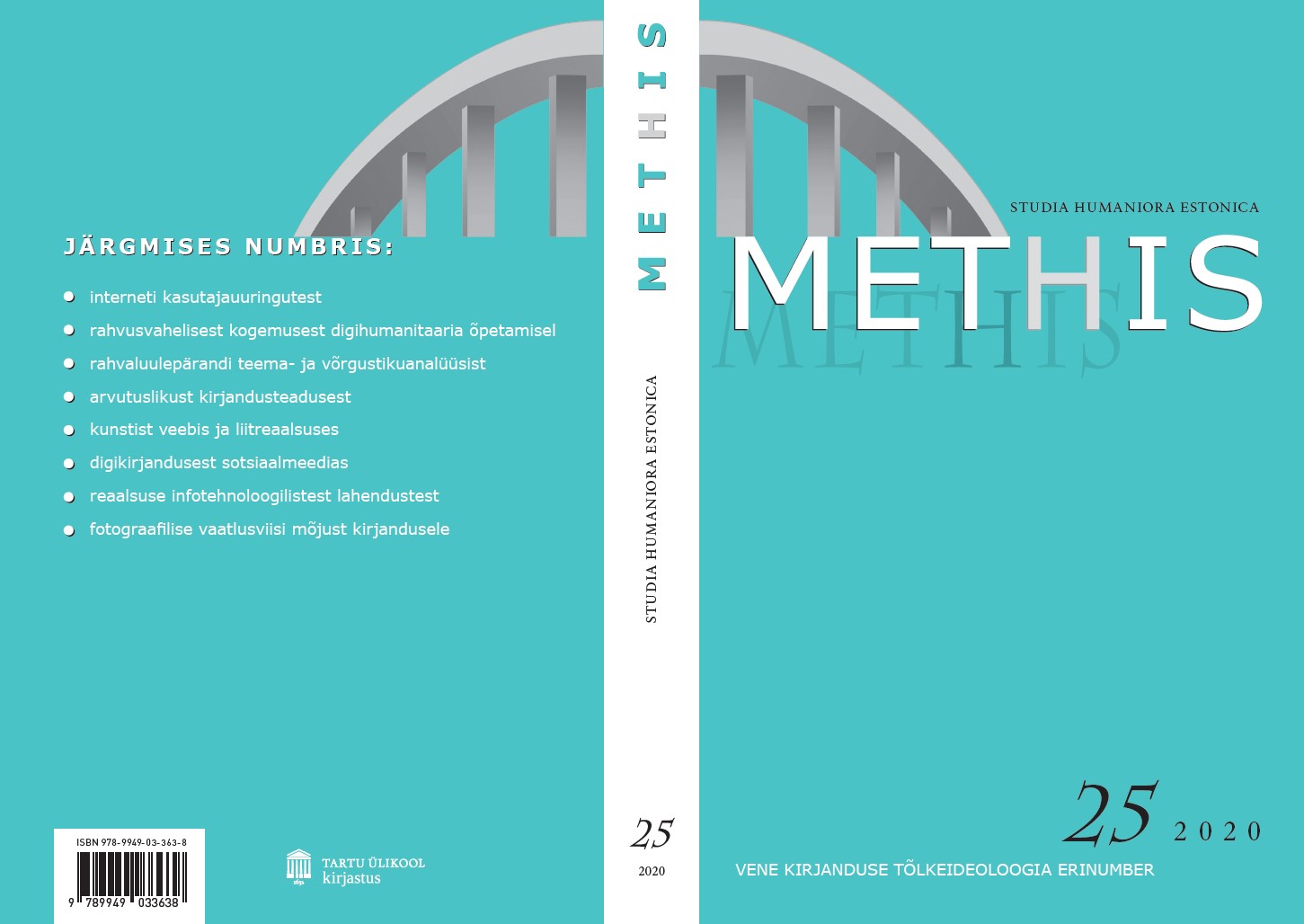„Bukvalistide kukutamise“ alguse juurde: 1934. aasta / Towards the Description of the Beginning of “the Overthrow of the Literalists”
DOI:
https://doi.org/10.7592/methis.v20i25.16572Keywords:
„kukutatud bukvalistid“, kodustav ja võõrapärastav tõlge, „nõukogude tõlkekoolkond“, heteronoomia tõlkeväljas, overthrow of the literalists, domestication and foreignisation in translation, the Soviet school of translation, heteronomy in the field of translationAbstract
Artiklis vaadeldakse eellugu nähtusele, mida Andrei Azov nimetas „bukvalistide kukutamiseks“ ning mis viis pooleks sajandiks nn nõukogude tõlkekoolkonna monopolini. Selle nähtuse algust näeme 1934. aastas, mil ilmusid ja said professionaalse arutelu objektiks silmapaistavate vene filoloog-tõlkijate Gustav Špeti ja Boriss Jarho novaatorlikud võõrapärastavad tõlked ja samal ajal seoses Nõukogude kirjanike esimese kongressiga leidis aset toores heteronoomia sissetung tõlkevälja ning tekkis sellest heteronoomiast kasu lõikav kriitiline diskursus. Olulisemate filoloog-tõlkijate hukkumine suure terrori ajal aitas kaasa kriitikute võidukäigule tõlkijate üle ja sealhulgas vene tõlkeajaloo retrospektiivsele moonutamisele, mida käesolev artikkel püüab parandada. Toetudes Lawrence Venuti tuntud teooriale võõrapärastavast ning kodustavast tõlkest, on seda dihhotoomiat diferentseeritud vastavalt nõukogude heteronoomsetele tingimustele.
The article discusses the pre-history of what Andrey Azov famously called “the overthrow of the literalists”, and the beginning of the half-a-century domination of the “Soviet school of translation” in Russia. It aims to locate and scrutinise the moment when the previous translation trend, later pejoratively labelled as “literalism”, gave way to the “Soviet school”.
In the post-war years, the Russian translators Evgeny Lann and Georgy Shengeli were subjected to harsh criticism as “literalists” by the literary critic, translator and translation theorist Ivan Kashkin. In the official history of Soviet translation as outlined in the Literary Encyclopedia (1968), they were presented as key figures of a translation trend, also labelled “formalist” and “technologically exact”, both post- and pre-war. This version of the history of Soviet translation, still resounding even in Azov’s study (2013), is strongly distorted and needs to be rewritten in a more analytical way. Primarily, the term “literalists”, that was used loosely and pejoratively at the time, can by no means serve as instrumental today. One of the most adequate self-labels of this trend in translation that had its heyday throughout the 1930s, notably in the activities of the Academia publishing house and the Commission for the Study of Literary Translation at the Moscow State Academy of Art Sciences (GAKhN), is “artistically scientific”. In order to describe the trend adequately it should be noted that the “nomination” of Lann and Shengeli as “literalists” and the main targets of post-war criticism owes primarily to the fact that the much more influential key figures of this “school”, mentioned in the Literary Encyclopedia (1934) as the “best present-day translators” – Mikhail Kuzmin, Adrian Pyotrovsky, Boris Yarkho, Mikhail Petrovsky – had either died (Kuzmin) or fallen victim to the great purges that hit also the GAKhNovites, including Gustav Shpet. Their names became unmentionable, while the translation projects and discussions of the 1930s associated with them could not be properly considered in translation histories. In order to reconstruct the true history of Soviet translation they have to be restored to their rightful place.
The pivotal point that marked both the acme of the “artistically scientific” translation, as well as the beginning of its demise, was the year 1934. It famously saw the First All-Union Congress of Writers at which translation was declared not the “private domain of a couple of literary pedants, not the academic theme for a philologist’s thesis, but an affair of utmost state importance”. Integration of translation into Stalinist national politics (discussions at the Writers’ Congress were centred on the interests of Soviet nationalities and on praising the free translations made by poets) resulted in a drastic decline of autonomy in the field and in the competition between critics profiting from the heteronomy concerning who would define the true “Soviet translation” and thus have the power to judge. The brilliant samples of scientifically founded translations of classics that appeared in 1934 – Boris Yarkho’s rendition of the medieval romance La Chanson de Roland and Gustav Shpet’s new Russian Dickens and Shakespeare (both to become virtually erased from the history of Soviet translation later on) became the focal point of the dispute over what “Soviet translation” should be.
The article reconstructs both Yarkho’s and Shpet’s philologically based translation premises and the conflicting reception of their work by fellow philologists and by politically motivated critics. The transcript of a 1934 discussion held after Evgeny Lann’s report on the principles of the new Dickens translations preserved in the archives clearly shows that, at the time, all discussants, including Kashkin, addressed not Lann but Shpet as the real source of these principles and that it was only after Shpet’s arrest and death that the spearhead of criticism was aimed at Lann (who, unlike Shpet, unfortunately lacked the philological and spiritual stamina and weight to confront it decisively). As for Yarkho’s attempt to invent a Russian poetic diction adequate for rendering French syllabic verse and the heterogeneous style of the medieval war epic, it was both daring and philologically grounded and had been highly praised as a model “Soviet translation” by major philologists working in the field of translation, e.g. Mikhail Alexeev, Alexander Smirnov and Rosalia Shor. At the same time, critics trying to speak in accordance with the political line would criticise it harshly, programmatically declaring their preference for the outdated free-verse translation into Russian made by de la Barthe.
In the history of Soviet translation, the transition from the “artistically scientific” or, to use a more familiar term, foreignising trend that had been flourishing throughout the 1930s and given brilliant practical as well as theoretical results, to a domesticating, ahistorical “Soviet school” that lacked theoretical reflection was not a natural evolution. Instead, it constituted a brutal intrusion of heteronomy into the field of translation, the triumph of politically oriented literary critics over professional translators and philologists that was strongly facilitated by the fact that many of the latter were repressed and, consequently, their names and works were erased from the history of Soviet translation.


